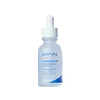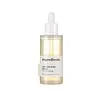What's inside
What's inside
 Key Ingredients
Key Ingredients

 Benefits
Benefits

 Concerns
Concerns

 Ingredients Side-by-side
Ingredients Side-by-side

Water
Skin ConditioningButylene Glycol
HumectantGlycerin
HumectantNiacinamide
Smoothing1,2-Hexanediol
Skin ConditioningBetaine
HumectantPanthenol
Skin ConditioningCarbomer
Emulsion StabilisingEthylhexylglycerin
Skin ConditioningSodium Hyaluronate
Humectant3-O-Ethyl Ascorbic Acid
Skin ConditioningCellulose Gum
Emulsion StabilisingTromethamine
BufferingSodium Trimetaphosphate
BufferingDipotassium Glycyrrhizate
HumectantPropanediol
SolventAdenosine
Skin ConditioningHydroxypropyl Bispalmitamide Mea
EmollientSodium Metaphosphate
BufferingGlyceryl Caprylate
EmollientPotassium Hydroxide
BufferingSodium Lactate
BufferingBiosaccharide Gum-1
HumectantCaprylic/Capric Triglyceride
MaskingPentylene Glycol
Skin ConditioningCitric Acid
BufferingHydroxyethyl Urea
HumectantPolyglyceryl-10 Stearate
Skin ConditioningCholesterol
EmollientPropylene Glycol
HumectantPotassium Cetyl Phosphate
EmulsifyingTocopherol
AntioxidantCeramide NP
Skin ConditioningMannitol
HumectantStearic Acid
CleansingSilica
AbrasiveAcrylates/Ammonium Methacrylate Copolymer
Hydrogenated Lecithin
EmulsifyingPalmitic Acid
EmollientOleic Acid
EmollientArachidic Acid
CleansingSphingolipids
EmollientWater, Butylene Glycol, Glycerin, Niacinamide, 1,2-Hexanediol, Betaine, Panthenol, Carbomer, Ethylhexylglycerin, Sodium Hyaluronate, 3-O-Ethyl Ascorbic Acid, Cellulose Gum, Tromethamine, Sodium Trimetaphosphate, Dipotassium Glycyrrhizate, Propanediol, Adenosine, Hydroxypropyl Bispalmitamide Mea, Sodium Metaphosphate, Glyceryl Caprylate, Potassium Hydroxide, Sodium Lactate, Biosaccharide Gum-1, Caprylic/Capric Triglyceride, Pentylene Glycol, Citric Acid, Hydroxyethyl Urea, Polyglyceryl-10 Stearate, Cholesterol, Propylene Glycol, Potassium Cetyl Phosphate, Tocopherol, Ceramide NP, Mannitol, Stearic Acid, Silica, Acrylates/Ammonium Methacrylate Copolymer, Hydrogenated Lecithin, Palmitic Acid, Oleic Acid, Arachidic Acid, Sphingolipids
Centella Asiatica Extract
CleansingPropanediol
SolventGlycerin
HumectantMethylpropanediol
Solvent1,2-Hexanediol
Skin ConditioningButylene Glycol
HumectantDiethoxyethyl Succinate
SolventWater
Skin ConditioningHydrolyzed Sclerotium Gum
HumectantC12-14 Alketh-12
EmulsifyingDipropylene Glycol
HumectantSodium Citrate
BufferingEthylhexylglycerin
Skin ConditioningCitric Acid
BufferingAzadirachta Indica Leaf Extract
Skin ConditioningJuniperus Virginiana Oil
MaskingTocopherol
AntioxidantPanthenol
Skin ConditioningMelia Azadirachta Flower Extract
Skin ConditioningCurcuma Longa Root Extract
MaskingFerula Galbaniflua Resin Oil
AntimicrobialPolyglyceryl-10 Myristate
Skin ConditioningBarosma Betulina Leaf Extract
PerfumingHydroxyacetophenone
AntioxidantPentylene Glycol
Skin ConditioningCaprylic/Capric Triglyceride
MaskingCaprylyl Glycol
EmollientHydrogenated Lecithin
EmulsifyingOlea Europaea Fruit Oil
MaskingSodium Hyaluronate
HumectantOcimum Sanctum Leaf Extract
Skin ConditioningCitrus Unshiu Peel Extract
MaskingSqualene
EmollientCetyl Ethylhexanoate
EmollientEthylhexyl Palmitate
EmollientButyrospermum Parkii Butter
Skin ConditioningCorallina Officinalis Extract
Skin ConditioningCeramide NP
Skin ConditioningCandida Bombicola/Glucose/Methyl Rapeseedate Ferment
AntimicrobialGlycolipids
Skin ConditioningMadecassoside
AntioxidantMadecassic Acid
Skin ConditioningAsiaticoside
AntioxidantAsiatic Acid
Skin ConditioningCentella Asiatica Extract, Propanediol, Glycerin, Methylpropanediol, 1,2-Hexanediol, Butylene Glycol, Diethoxyethyl Succinate, Water, Hydrolyzed Sclerotium Gum, C12-14 Alketh-12, Dipropylene Glycol, Sodium Citrate, Ethylhexylglycerin, Citric Acid, Azadirachta Indica Leaf Extract, Juniperus Virginiana Oil, Tocopherol, Panthenol, Melia Azadirachta Flower Extract, Curcuma Longa Root Extract, Ferula Galbaniflua Resin Oil, Polyglyceryl-10 Myristate, Barosma Betulina Leaf Extract, Hydroxyacetophenone, Pentylene Glycol, Caprylic/Capric Triglyceride, Caprylyl Glycol, Hydrogenated Lecithin, Olea Europaea Fruit Oil, Sodium Hyaluronate, Ocimum Sanctum Leaf Extract, Citrus Unshiu Peel Extract, Squalene, Cetyl Ethylhexanoate, Ethylhexyl Palmitate, Butyrospermum Parkii Butter, Corallina Officinalis Extract, Ceramide NP, Candida Bombicola/Glucose/Methyl Rapeseedate Ferment, Glycolipids, Madecassoside, Madecassic Acid, Asiaticoside, Asiatic Acid
Ingredients Explained
These ingredients are found in both products.
Ingredients higher up in an ingredient list are typically present in a larger amount.
1,2-Hexanediol is a synthetic liquid and another multi-functional powerhouse.
It is a:
- Humectant, drawing moisture into the skin
- Emollient, helping to soften skin
- Solvent, dispersing and stabilizing formulas
- Preservative booster, enhancing the antimicrobial activity of other preservatives
Butylene Glycol (or BG) is used within cosmetic products for a few different reasons:
Overall, Butylene Glycol is a safe and well-rounded ingredient that works well with other ingredients.
Though this ingredient works well with most skin types, some people with sensitive skin may experience a reaction such as allergic rashes, closed comedones, or itchiness.
Learn more about Butylene GlycolThis ingredient is an emollient, solvent, and texture enhancer. It is considered a skin-softener by helping the skin prevent moisture loss.
It helps thicken a product's formula and makes it easier to spread by dissolving clumping compounds.
Caprylic Triglyceride is made by combining glycerin with coconut oil, forming a clear liquid.
While there is an assumption Caprylic Triglyceride can clog pores due to it being derived from coconut oil, there is no research supporting this.
Learn more about Caprylic/Capric TriglycerideCeramide NP is a type of ceramide.
Ceramides are intercellular lipids naturally found in our skin that bonds dead skin cells together to create a barrier. They are known for their ability to hold water and thus are a great ingredient for dry skin.
Ceramides are an important building block for our skin barrier. A stronger barrier helps the skin look more firm and hydrated. By bolstering the skin ceramides act as a barrier against irritating ingredients. This can help with inflammation as well.
If you would like to eat ceramides, sweet potatoes contain a small amount.
Read more about other common types of ceramides here:
Ceramide AP
Ceramide EOP
Citric Acid is an alpha hydroxy acid (AHA) naturally found in citrus fruits like oranges, lemons, and limes.
Like other AHAs, citric acid can exfoliate skin by breaking down the bonds that hold dead skin cells together. This helps reveal smoother and brighter skin underneath.
However, this exfoliating effect only happens at high concentrations (20%) which can be hard to find in cosmetic products.
Due to this, citric acid is usually included in small amounts as a pH adjuster. This helps keep products slightly more acidic and compatible with skin's natural pH.
In skincare formulas, citric acid can:
While it can provide some skin benefits, research shows lactic acid and glycolic acid are generally more effective and less irritating exfoliants.
Most citric acid used in skincare today is made by fermenting sugars (usually from molasses). This synthetic version is identical to the natural citrus form but easier to stabilize and use in formulations.
Read more about some other popular AHA's here:
Learn more about Citric AcidEthylhexylglycerin (we can't pronounce this either) is commonly used as a preservative and skin softener. It is derived from glyceryl.
You might see Ethylhexylglycerin often paired with other preservatives such as phenoxyethanol. Ethylhexylglycerin has been found to increase the effectiveness of these other preservatives.
Glycerin is already naturally found in your skin. It helps moisturize and protect your skin.
A study from 2016 found glycerin to be more effective as a humectant than AHAs and hyaluronic acid.
As a humectant, it helps the skin stay hydrated by pulling moisture to your skin. The low molecular weight of glycerin allows it to pull moisture into the deeper layers of your skin.
Hydrated skin improves your skin barrier; Your skin barrier helps protect against irritants and bacteria.
Glycerin has also been found to have antimicrobial and antiviral properties. Due to these properties, glycerin is often used in wound and burn treatments.
In cosmetics, glycerin is usually derived from plants such as soybean or palm. However, it can also be sourced from animals, such as tallow or animal fat.
This ingredient is organic, colorless, odorless, and non-toxic.
Glycerin is the name for this ingredient in American English. British English uses Glycerol/Glycerine.
Learn more about GlycerinHydrogenated Lecithin is created from the hydrogenation of lecithin (a group of phospholipids). Hydrogenation is a chemical reaction between hydrogen and another element.
This ingredient is an emollient and emulsifier. As an emollient, it helps soften skin by trapping moisture within. As an emulsifier, it prevents oil and water ingredients from separating.
Panthenol is a common ingredient that helps hydrate and soothe the skin. It is found naturally in our skin and hair.
There are two forms of panthenol: D and L.
D-panthenol is also known as dexpanthenol. Most cosmetics use dexpanthenol or a mixture of D and L-panthenol.
Panthenol is famous due to its ability to go deeper into the skin's layers. Using this ingredient has numerous pros (and no cons):
Like hyaluronic acid, panthenol is a humectant. Humectants are able to bind and hold large amounts of water to keep skin hydrated.
This ingredient works well for wound healing. It works by increasing tissue in the wound and helps close open wounds.
Once oxidized, panthenol converts to pantothenic acid. Panthothenic acid is found in all living cells.
This ingredient is also referred to as pro-vitamin B5.
Learn more about PanthenolPentylene glycol is typically used within a product to thicken it. It also adds a smooth, soft, and moisturizing feel to the product. It is naturally found in plants such as sugar beets.
The hydrophilic trait of Pentylene Glycol makes it a humectant. As a humectant, Pentylene Glycol helps draw moisture from the air to your skin. This can help keep your skin hydrated.
This property also makes Pentylene Glycol a great texture enhancer. It can also help thicken or stabilize a product.
Pentylene Glycol also acts as a mild preservative and helps to keep a product microbe-free.
Some people may experience mild eye and skin irritation from Pentylene Glycol. We always recommend speaking with a professional about using this ingredient in your routine.
Pentylene Glycol has a low molecular weight and is part of the 1,2-glycol family.
Learn more about Pentylene GlycolPropanediol is an all-star ingredient. It softens, hydrates, and smooths the skin.
It’s often used to:
Propanediol is not likely to cause sensitivity and considered safe to use. It is derived from corn or petroleum with a clear color and no scent.
Learn more about PropanediolSodium Hyaluronate is hyaluronic acid's salt form. It is commonly derived from the sodium salt of hyaluronic acid.
Like hyaluronic acid, it is great at holding water and acts as a humectant. This makes it a great skin hydrating ingredient.
Sodium Hyaluronate is naturally occurring in our bodies and is mostly found in eye fluid and joints.
These are some other common types of Hyaluronic Acid:
Learn more about Sodium HyaluronateTocopherol (also known as Vitamin E) is a common antioxidant used to help protect the skin from free-radicals and strengthen the skin barrier. It's also fat soluble - this means our skin is great at absorbing it.
Vitamin E also helps keep your natural skin lipids healthy. Your lipid skin barrier naturally consists of lipids, ceramides, and fatty acids. Vitamin E offers extra protection for your skin’s lipid barrier, keeping your skin healthy and nourished.
Another benefit is a bit of UV protection. Vitamin E helps reduce the damage caused by UVB rays. (It should not replace your sunscreen). Combining it with Vitamin C can decrease sunburned cells and hyperpigmentation after UV exposure.
You might have noticed Vitamin E + C often paired together. This is because it is great at stabilizing Vitamin C. Using the two together helps increase the effectiveness of both ingredients.
There are often claims that Vitamin E can reduce/prevent scarring, but these claims haven't been confirmed by scientific research.
Learn more about TocopherolWater. It's the most common cosmetic ingredient of all. You'll usually see it at the top of ingredient lists, meaning that it makes up the largest part of the product.
So why is it so popular? Water most often acts as a solvent - this means that it helps dissolve other ingredients into the formulation.
You'll also recognize water as that liquid we all need to stay alive. If you see this, drink a glass of water. Stay hydrated!
Learn more about Water